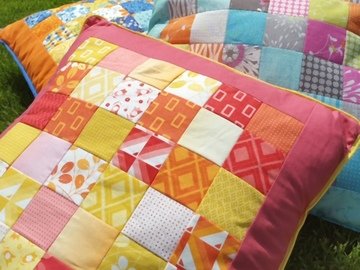A fabric dishcloth offers numerous advantages. Not only is it environmentally friendly, as it is reusable and therefore creates less waste, but it is also extremely durable, which saves money in the long run. These rags have effective cleaning power and can thoroughly remove dirt and grease.
Another important aspect is that they are environmentally friendly. Cloth dishcloths help reduce waste and minimize environmental impact, as many commercial dishcloths and sponges are plastic. You can even upcycle old towels to give them a new use. For sterilization, these rags can simply be boiled to prevent bacterial growth and ensure hygiene.
Materials you will need:
- Waffle piqué fabric or terry cloth (approx. 20 cm x 20 cm), alternatively other absorbent fabric
- Suitable thread
- Sewing machine or needle and thread
- scissors
- pins
- Measuring tape or ruler
- Iron
Step-by-step instructions:
Step 1: Preparation
Start by washing and ironing the waffle pique fabric to remove any wrinkles or impurities. It will also prevent the rag from warping afterwards if it shrinks a bit during washing.
Step 2: Cut the fabric
Measure and cut two 20cm x 20cm squares from the waffle piqué fabric. This will be the base of your rinse cloth. This includes a 1 cm seam allowance.
.png)
Step 3: Hanging loop (optional)
If you want to add a hanging loop for your rag, cut a piece of fabric ribbon (woven ribbon) of your choice about 8 inches long. Instead of weaving tape, you can also use ready-made bias tape, a piece of cotton yarn or a fabric strip. If you decide to use a fabric strip, cut an 8 x 5 cm piece, place it lengthwise and sew the long side together with a 1 cm seam allowance. Then turn the strip over and press the seam smooth.
Step 4: Sewing the rinse cloth
Now place the two squares right sides together. Place the hanging loop near one corner with the loop facing in and sew once all the way around with a 1 cm seam allowance.
.png)
For this, it is best to use a straight stitch with a length of 3 mm. Secure the seam at the beginning and end with a few back stitches.
.png)
Leave a turning opening on one side.
So you simply sew the corners:
Step 5: Turning
Now cut away the seam allowance at the corners diagonally as shown in the picture. Turn the cloth through the turning opening and shape the corners especially well (a ruler or a knitting or crochet needle is particularly suitable for this).
.png)
.png)
Step 6: Finishing
Now sew the entire cloth once again, close the turnaround opening at the same time. Trim any excess threads and iron the entire dishcloth once more to smooth out all the seams and make sure it looks neat.
.png)
You have successfully sewn a square dishcloth made of waffle piqué fabric. This rag is ideal for kitchen work and will add a touch of elegance to your kitchen. Have fun sewing and cleaning!
.PNG)






























































































































































